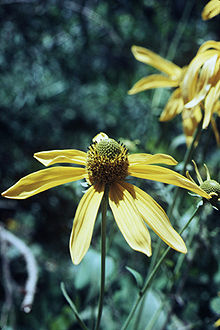Printed at http://www.newmoonnursery.com/index.cfm/

Perennial for wet spaces, this Rudbeckia is naturally found in wetland areas, along streams and ponds, and wet woodland areas. Photo credit: USDA-NRCS PLANTS Database
Rudbeckia laciniata
Green-headed coneflower
Native to North America
FIRST IMPRESSIONS: Rudbeckia laciniata is a native clump forming perennial with multiple upright stems. The leaves are large, dark green and deeply lobed. From summer until fall foliage is topped with clusters of showy daisy-like flower heads. Each head consists of a yellow-green globular cone surrounded by drooping yellow rays. This rhizomatous species thrives in partly shaded sites with moist or wet fertile soils.
HABITAT & HARDINESS: Rudbeckia laciniata occurs in most of the southern Canadian provinces and in all the contiguous United States except for California, Nevada and Oregon.
Plants are indigenous to bottomland forests, moist meadows, borders and clearings of moist woods, shaded sloughs, shaded banks of rivers, creeks and ponds, calcareous seeps and wet to moist fields or pastures.
This species is hardy from USDA Zones 4-9.
PLANT DESCRIPTION: Rudbeckia laciniata is an upright lanky perennial that branches in the top half.
The stems are smooth, light green and clad in alternate drooping blades. Basal leaves are up to 12” long and 12” across with narrowly winged petioles and 3-7 large toothed lobes. As the stems rise, the leaves become progressively smaller and unlobed.
For 1-2 months beginning in summer, stems terminate in clusters of daisy-like heads. Each head is 2-3” across with a nubby globular cone wreathed by 6-12 clear yellow oblong ray florets.
The young cones are green with unique widely spaced disc florets that impart a pincushion-like appearance. The cones turn yellow as the disc florets mature and finally morph into golden brown seed heads as winter approaches.
Plants are 3-8’ tall with a 2-4’ spread. This species often forms colonies from long underground rhizomes.
CULTURAL & MAINTENANCE NEEDS: Rudbeckia laciniata thrives in part sun and moist soil. Plants tolerate wet soils, seasonal flooding, heat and humidity.
Plants are pest resistant and foliage is unpalatable to deer and other herbivores.
This species is not very drought tolerant. It may survive in sunny well drained sites but leaves are usually wilted with brown edges.
In good growing situations with plenty of moisture, plants may spread aggressively from rhizomes.
LANDSCAPE USES: Rudbeckia laciniata is a dramatic Accent for a Wildlife Garden or moist Meadow. Plants are also used as Butterfly Nectar Plants or as part of a Grouping or Mass Planting. This wildflower offers Showy Blooms and provides Erosion Control. It is useful in Stormwater Management and Rain Gardens. It can be used in Cottage Gardens, Deer Resistant Plantings, Low Maintenance Plantings, Perennial Borders or Shade Gardens.
COMPANION & UNDERSTUDY PLANTS: Try pairing Rudbeckia laciniata with Aster novi-belgii, Deschampsia caespitosa, Eupatorium perfoliatum, Lobelia cardinalis, Penstemon calycosus, Carex amphibola, Panicum virgatum or Sorghastrum nutans.
Rudbeckia laciniata 'Autumn Sun' is a possible substitute for sunny rain gardens and stormwater management projects.
TRIVIA: Blossoms attract a variety of bees, pollinating flies, beneficial wasps, butterflies, skippers and moths. Caterpillars of Silvery Checkerspot Butterflies forage on the foliage and seeds are sometimes eaten by goldfinches. Foliage is not particularly palatable to deer and other herbivores.
Rudbeckia laciniata can be differentiated from related species due to their nubby green to yellow cones. Most other Rudbeckia spp. have brown, black or gray cones. Foliage of this species has 3-7 deep lobes while most other Rudbeckia spp. have fewer or no lobes.
Height:
3-8 ftSpread:
2-4 ftSpacing:
3 ftUSDA Hardiness Zone:
3-9Bloom Color:
YellowRudbeckia laciniata Characteristics
Attracts Wildlife
- Butterflies
- Pollinators
Attributes
- Dried Flower
- Rain Garden
- Cut Flower
- Coastal
- Clay Soil
- Naturalizing
- Bog
- Long Blooming
- East-Coast Native
Exposure
- Full Sun to Partial Shade
Deer Resistant
- Deer Resistant
Flowering Months
- September
- August
- July
Foliage Color
- Green
Growth Rate
- Medium
Juglans nigra Tolerance (Black Walnut)
- Yes
Salt Tolerance
- Low
Soil Moisture Preference
- Moist to Wet
Interesting Notes:
For more information on this plant, visit the USDA PLANTS Database: http://plants.usda.gov/java/profile?symbol=RULA3
